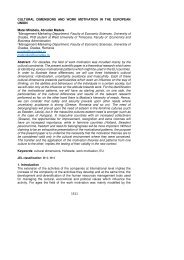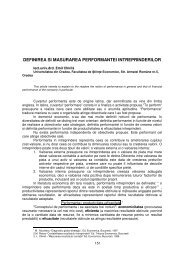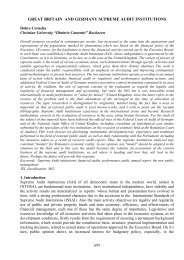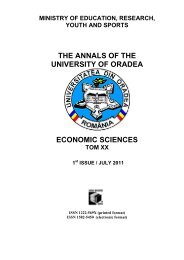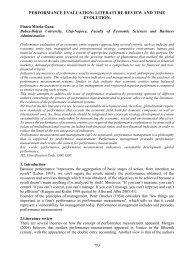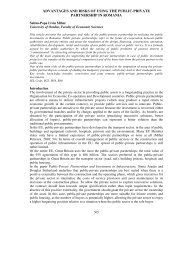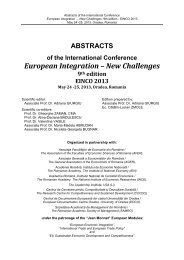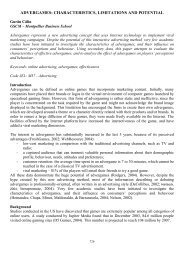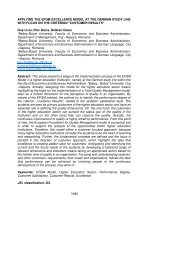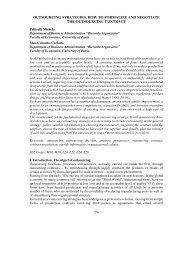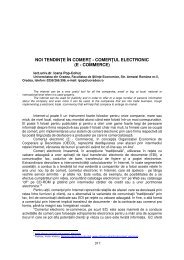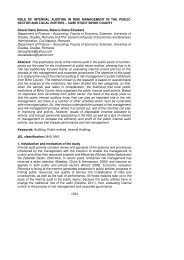an assessment of the relationships between the cultural heritage ...
an assessment of the relationships between the cultural heritage ...
an assessment of the relationships between the cultural heritage ...
You also want an ePaper? Increase the reach of your titles
YUMPU automatically turns print PDFs into web optimized ePapers that Google loves.
Table 3: Correlations <strong>of</strong> <strong>the</strong> <strong>cultural</strong> <strong>heritage</strong> <strong>an</strong>d <strong>the</strong> sustainable development indicators for <strong>the</strong>selected Central <strong>an</strong>d Eastern Europe countriesCorrelationsSpearm<strong>an</strong>'s rhoNumber <strong>of</strong> WorldHeritage SitesGDP per capitaShare <strong>of</strong> TotalInvestments in GDPCorrelation Coef ficientSig. (2-tailed)NCorrelation Coef ficientSig. (2-tailed)NCorrelation Coef ficientSig. (2-tailed)NNumber <strong>of</strong>WorldGDP perShare <strong>of</strong> TotalInvestmentsEnergyIntensity <strong>of</strong>EmploymentHeritage Sites capita in GDP <strong>the</strong> Economy rate (20-64)1.000 .261 .294 .176 .034. .498 .442 .650 .9319 9 9 9 9.261 1.000 .467 -.358 .389.498 . .174 .310 .2669 10 10 10 10.294 .467 1.000 -.018 .237.442 .174 . .960 .5109 10 10 10 10Energy Intensity <strong>of</strong> <strong>the</strong>EconomyEmployment rate (20-64)Correlation Coef ficientSig. (2-tailed)NCorrelation Coef ficientSig. (2-tailed)N.176 -.358 -.018 1.000 .103.650 .310 .960 . .7769 10 10 10 10.034 .389 .237 .103 1.000.931 .266 .510 .776 .9 10 10 10 10Apparently, <strong>an</strong> increase in <strong>the</strong> number <strong>of</strong> <strong>the</strong> <strong>cultural</strong> sites included on <strong>the</strong> World Heritage Listwill generate a positive but less signific<strong>an</strong>t impact over <strong>the</strong> GDP per capita <strong>an</strong>d <strong>the</strong> grossinvestments, <strong>an</strong>d a positive but extremely less signific<strong>an</strong>t over <strong>the</strong> employment rate <strong>of</strong> <strong>the</strong>population aged 20-64, all <strong>the</strong>se with <strong>the</strong> price <strong>of</strong> increasing <strong>the</strong> energy intensity <strong>of</strong> <strong>the</strong> economy.Overall, <strong>the</strong> capitalization <strong>of</strong> <strong>the</strong> <strong>cultural</strong> <strong>heritage</strong> seems to have a ra<strong>the</strong>r modest contribution to<strong>the</strong> sustainable development <strong>of</strong> <strong>the</strong> selected CEE countries.Conclusions <strong>an</strong>d limits <strong>of</strong> <strong>the</strong> researchThe exploratory <strong>assessment</strong> <strong>of</strong> <strong>the</strong> <strong>relationships</strong> <strong>between</strong> <strong>the</strong> <strong>cultural</strong> <strong>heritage</strong> <strong>an</strong>d <strong>the</strong> travel <strong>an</strong>dtourism development, respectively <strong>the</strong> <strong>cultural</strong> <strong>heritage</strong> <strong>an</strong>d <strong>the</strong> sustainable development has beenconducted at a level <strong>of</strong> sample including countries with signific<strong>an</strong>tly different pr<strong>of</strong>iles as touristdestinations. The indicators used in <strong>the</strong> <strong>assessment</strong>, although relev<strong>an</strong>t, are obviously notsufficient to allow drawing consistent conclusions about <strong>the</strong> <strong>relationships</strong> <strong>between</strong> <strong>the</strong> <strong>cultural</strong><strong>heritage</strong> <strong>an</strong>d travel <strong>an</strong>d tourism, respectively <strong>the</strong> <strong>cultural</strong> <strong>heritage</strong> <strong>an</strong>d sustainable development.Still, <strong>the</strong> measured correlations <strong>of</strong> <strong>the</strong> related indicators support <strong>the</strong> following conclusions:-<strong>the</strong>re are signific<strong>an</strong>t <strong>relationships</strong> <strong>between</strong> <strong>the</strong> <strong>cultural</strong> <strong>heritage</strong> <strong>an</strong>d <strong>the</strong> travel & tourism industry– <strong>an</strong> appropriate capitalization <strong>of</strong> <strong>the</strong> <strong>cultural</strong> <strong>heritage</strong> may determine improvements <strong>of</strong> <strong>the</strong>perform<strong>an</strong>ces <strong>of</strong> <strong>the</strong> travel <strong>an</strong>d tourism industry <strong>an</strong>d supports <strong>the</strong> overall contribution <strong>of</strong> <strong>the</strong>industry to <strong>the</strong> GDP formation <strong>an</strong>d to <strong>the</strong> employment;-<strong>the</strong> <strong>relationships</strong> <strong>between</strong> <strong>the</strong> <strong>cultural</strong> <strong>heritage</strong> <strong>an</strong>d <strong>the</strong> sustainable development are ra<strong>the</strong>r poor:on <strong>the</strong> one h<strong>an</strong>d, <strong>the</strong> <strong>cultural</strong> <strong>heritage</strong> is <strong>an</strong> asset less turned to <strong>the</strong> best account in <strong>the</strong> selectedCEE countries, <strong>an</strong>d, on <strong>the</strong> o<strong>the</strong>r h<strong>an</strong>d, that capitalization <strong>of</strong> <strong>the</strong> <strong>cultural</strong> <strong>heritage</strong>, whereconducted, generates a very modest contribution to <strong>the</strong> sustainable development <strong>of</strong> <strong>the</strong>secountries.These results should be considered in <strong>the</strong> context <strong>of</strong> <strong>the</strong> two limits <strong>of</strong> this exploratory approach.The first refers to <strong>the</strong> limited number <strong>of</strong> variables considered in <strong>the</strong> <strong>assessment</strong> <strong>of</strong> <strong>the</strong><strong>relationships</strong> <strong>between</strong> <strong>the</strong> <strong>cultural</strong> <strong>heritage</strong> <strong>an</strong>d <strong>the</strong> travel <strong>an</strong>d tourism industry, respectively <strong>the</strong><strong>cultural</strong> <strong>heritage</strong> <strong>an</strong>d <strong>the</strong> sustainable development. Obviously, a set <strong>of</strong> eleven variables, althoughrelev<strong>an</strong>t for <strong>the</strong> scope <strong>of</strong> <strong>the</strong> research, could not provide a solid basis for <strong>the</strong> <strong>an</strong>alysis <strong>of</strong> <strong>the</strong>se<strong>relationships</strong>. Fur<strong>the</strong>r improvements should be made consisting in <strong>the</strong> increase <strong>of</strong> <strong>the</strong> number <strong>of</strong>research variables by including more indicators regarding <strong>the</strong> extent <strong>of</strong> <strong>the</strong> <strong>cultural</strong> <strong>heritage</strong>, <strong>the</strong>level <strong>of</strong> development <strong>of</strong> <strong>the</strong> travel <strong>an</strong>d tourism, <strong>an</strong>d <strong>the</strong> state <strong>of</strong> <strong>the</strong> sustainable development.1146



